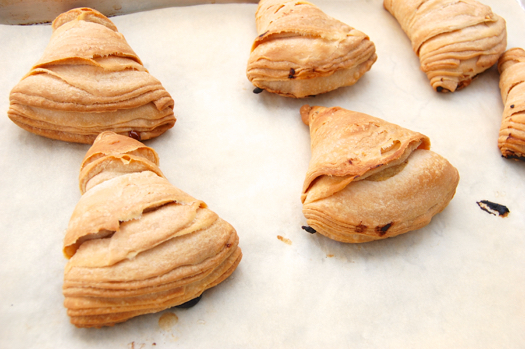Ehem.

Lots going wrong here, but the problem at the center of it all is a lack of elasticity in my dough. This stems from the fact that it’s so darn rich. All the fat is lubricating the gluten (protein) molecules in the dough, preventing them from linking up with one another and forming a stretchy network.
Without that elasticity the dough doesn’t pull out into a thin enough sheet, and that has implications for everything from the number of layers in the roll to the way the dough lays down when I shape my little shells here. It affects the browning and of course the taste which is short crust-like, not puff pastry-like. Too firm, too crumbly, too greasy. I’m gonna cut the fat in half and see what that buys me.
OK, so they aren’t perfect. So what? You are still one (big) step ahead of me, who hasn’t had the guts to experiment as you have. Congratulations on getting through the first wicket. Celebrate the initial victory!
I have to say it does feel good, Brian. I confess I was dreading this first attempt a little (a lot). Having had the first one turn out pretty so-so I am, as you say, in the game now. I’m pretty sure a leaner dough will improve these a lot.
More soon!
– Joe
I would eat those in a nanosecond.
lol…thanks for that, Chana! They aren’t horrible to eat, strictly speaking. But I think they can be a lot better! 😉
Cheers and thanks!
– Joe
You’re on your way! And believe me, even though I know (I know!) how frustrating a failed attempt is, it is also rather comforting for the rest of us to know that even someone as pro as you needs a bit of practice. It makes me feel more confident about perhaps taking a second chance at these (once I get to steal all of your tips…)
Haha…thanks, Ashley! With this first actual attempt done I see this for what it is: a whole different laminating technique. Considering how long it took me to learn regular folding lamination, some patience is warranted on my part. Too bad I have so little!
Cheers and more soon,
– Joe
What kind of laminating technique are you looking for? Chef Kenji-Alt had a great discussion on pie crust last year. I doubt pie crust is what you’re going for but its still a great article. I’m really looking forward to your finished product as I love reading your pastry theory. Hang in there you’ll get it! 🙂
Hey Elle!
I’m not looking for anything per se…just to get better at this. 😉
More on this soon — hopefully today!
Cheers,
– Joe
I made meat pies using a recipe that called for a A LOT of fat in the dough, it ended up being a sandy mess when cooked because all of the gluten was coated. Talk about an untested recipe. I can understand your frustration and determination–we appreciate your testing efforts that will result in success for us!
That’s exactly what’s going on here, Anna, too much fat! Strange how so many of the sfogliatelle recipes I’ve found in English call for a hyper-rich dough. Could it be a diversionary tactic by Neapolitans who just don’t want us to learn how to duplicate the things?
I’ll figure it out in the end. Thanks for the comment!
– Joe
Okay, here’s a silly question – what happens if you make the dough without the fat initially, then add the fat when there is a more solid gluten structure? Is it just unable to absorb the fat at that point?
That’s not silly at all, Michael. In fact I’m thinking about doing that exact thing this afternoon. It’s how brioche is made: the dough is kneaded first to developed the gluten. Once that’s accomplished the fat goes in. Since fat can’t disrupt a gluten network that’s already been formed, the result is a very elastic yet rich dough. I think I’ll still drop the total amount of fat, but change the process to incorporate that technique. We’ll see how it works!
Cheers and thanks!
– Joe